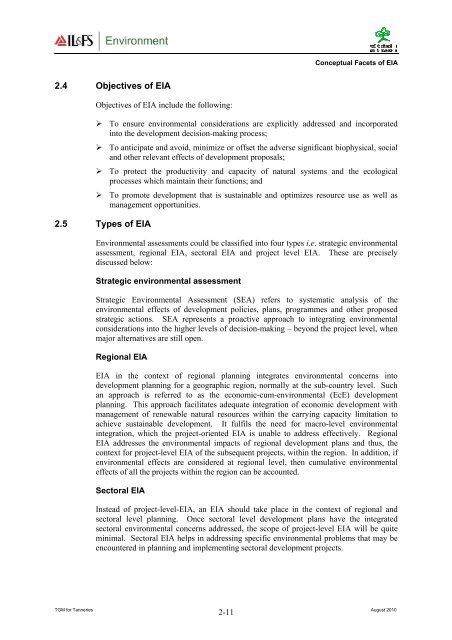Leather/Skin/Hide Processing Industry - Environmental Clearance
Leather/Skin/Hide Processing Industry - Environmental Clearance
Leather/Skin/Hide Processing Industry - Environmental Clearance
You also want an ePaper? Increase the reach of your titles
YUMPU automatically turns print PDFs into web optimized ePapers that Google loves.
Conceptual Facets of EIA2.4 Objectives of EIAObjectives of EIA include the following: To ensure environmental considerations are explicitly addressed and incorporatedinto the development decision-making process; To anticipate and avoid, minimize or offset the adverse significant biophysical, socialand other relevant effects of development proposals; To protect the productivity and capacity of natural systems and the ecologicalprocesses which maintain their functions; and To promote development that is sustainable and optimizes resource use as well asmanagement opportunities.2.5 Types of EIA<strong>Environmental</strong> assessments could be classified into four types i.e. strategic environmentalassessment, regional EIA, sectoral EIA and project level EIA. These are preciselydiscussed below:Strategic environmental assessmentStrategic <strong>Environmental</strong> Assessment (SEA) refers to systematic analysis of theenvironmental effects of development policies, plans, programmes and other proposedstrategic actions. SEA represents a proactive approach to integrating environmentalconsiderations into the higher levels of decision-making – beyond the project level, whenmajor alternatives are still open.Regional EIAEIA in the context of regional planning integrates environmental concerns intodevelopment planning for a geographic region, normally at the sub-country level. Suchan approach is referred to as the economic-cum-environmental (EcE) developmentplanning. This approach facilitates adequate integration of economic development withmanagement of renewable natural resources within the carrying capacity limitation toachieve sustainable development. It fulfils the need for macro-level environmentalintegration, which the project-oriented EIA is unable to address effectively. RegionalEIA addresses the environmental impacts of regional development plans and thus, thecontext for project-level EIA of the subsequent projects, within the region. In addition, ifenvironmental effects are considered at regional level, then cumulative environmentaleffects of all the projects within the region can be accounted.Sectoral EIAInstead of project-level-EIA, an EIA should take place in the context of regional andsectoral level planning. Once sectoral level development plans have the integratedsectoral environmental concerns addressed, the scope of project-level EIA will be quiteminimal. Sectoral EIA helps in addressing specific environmental problems that may beencountered in planning and implementing sectoral development projects.TGM for Tanneries August 20102-11
















